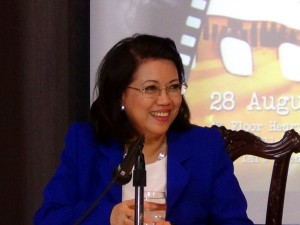MANILA, Philippines – Chief Justice Maria Lourdes Sereno questioned on Tuesday the timing of the House of Representatives’ inquiry into the Supreme Court’s Judiciary Development Fund (JDF), adding that such a move doesn’t show a healthy relationship between the two branches of government.
She said in a letter addressed to Speaker Feliciano Belmonte dated August 4 that the “timing and context in which a Committee of the House is proposing to inquire into the JDF as indicated in its letter, is that they leave much to be desired, and at this point, do not seem to be fully cognizant of the kind of healthy relationship that should exist between, on the one hand, the House of Representatives and on the other, the Supreme Court.”
The House, through Belmonte, sent a letter to Sereno also on August 4 inviting her to a meeting on the initial deliberation on House Bill 4690 which seeks to amend Presidential Decree 1949 or the law that created the JDF.
Sereno reminded Congress that Judiciary was a co-equal branch of government and inviting its head to a public hearing would be inappropriate.
“From the phrase ‘initial deliberation,’ I take it that the meeting contemplated appears to be a public hearing on the two pending bills. As Speaker of the House, you would appreciate my position that asking the Head of a co-equal branch of government to provide her ‘views, comments, and recommendations’ on the two bills at this stage might be premature considering the venue at which it is being proposed to be heard, inappropriate…I am certain you are also contemplating the policy ramifications of the Committee’s request on judicial independence,” Sereno said.
Aside from Sereno, also invited by the House committee on justice headed by Iloilo Representative Niel Tupas Jr. were Deputy Court Administrator Raul Villanueva and lawyer Corazon Ferrer-Flores, chief of the high court’s Fiscal Management and Budget Office (FMBO). But both officials informed the high court justices and sought their guidance.
Sereno said the matter would be discussed at the en banc meeting today, Tuesday.
House Bill 4690 initiated by Tupas is described as ‘An act reforming the administration of the JDF, mandating transparency and accountability in the administration thereof, transferring the administration thereof from the Supreme Court to the Bureau of Treasury, enacting appropriate audit and reportorial requirements. The second Bill amends the JDF to become the Judiciary Support Funds.
The JDF did not come from the government coffers, it is a fund collected by courts nationwide from docket and other court fees.
The JDF was created by virtue of Presidential Decree 1949, dated July 18, 1984 “in order to preserve and enhance the independence of the judiciary at all times and safeguard the integrity of its members,” being the lone apolitical branch of government.
Under PD 1949, 80-percent of the JDF shall be used to augment the allowances of justices, judges, and court personnel; the remaining 20-percent for office equipment and facilities.
Sereno pointed out in her letter that under PD 1949, the Commission on Audit was mandated to do a quarterly audit of the fund — its “receipts, revenues, uses, disbursements and expenditures.” The high court has also posted on its website how the JDF was spent. The remaining, or its savings are deposited in its own account at the Land Bank of the Philippines.
Tupas revived his bid to amend the law creating the JDF following President Benigno Aquino III’s speech assailing the high court for declaring the Disbursement Acceleration Program (DAP) as unconstitutional.
Aquino said the high court should not let the third branch of government–Congress to interfere in the rift between the executive and the judiciary.
RELATED STORIES
No ‘resbak’ in bill to amend judiciary’s discretionary fund—Fariñas
Palace House allies to SC: We are also supreme
SC: We’ve no discretion over judiciary funds
